Driving Boats in Rough Seas - Head Seas
By Dag Pike
Most of us go out to sea for pleasure, which means avoiding rough seas because there is not much pleasure when the going gets rough. However, you have to be prepared as there is always the chance of being caught out by short term changes in the weather.
Most powerboat hulls are not specifically designed for operating in rough seas, with some notable exceptions such as some trawler yachts. This means that in rough sea conditions, a powerboat will have to be nursed through the waves. In very rough conditions, planing powerboats will have to come down to displacement speeds but they are less capable when operating at slow speeds. You might also ponder why it always seems to happen that when it gets rough, the waves are always coming from ahead.
Challenging seas are those in which the throttles and the speed cannot be left set and the boat cannot be left to take its course through the waves. Instead, speed has to be reduced or throttles operated continuously to negotiate the boat through the waves. Much depends on the size and construction of the boat as to what might be considered to be rough conditions. But, in general, we are talking here about the seas generated by winds of 25 knots or more. In this first article, we will look at operating in head seas.
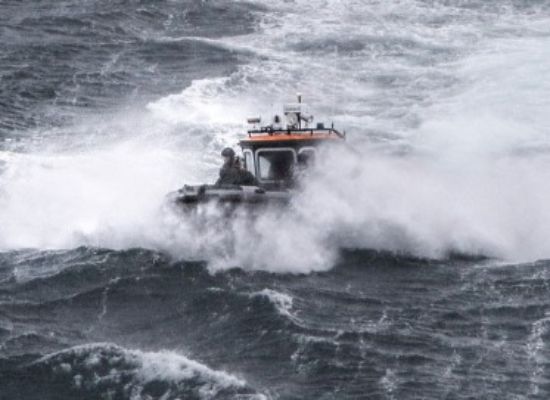
When operating in a head sea, the main thing to do with a displacement hull is to find a speed at which the boat runs comfortably. Provided the boat is strongly built, and most are these days, even in quite rough seas it is possible to find a speed where the boat will lift over the wave and drop down the other side without too much discomfort to the boat and the crew. Matching the speed to the conditions is the secret of operating in head seas, provided the waves have a normal gradient and a wavelength, which allows the boat to operate without any undue change in attitude.
When a displacement boat is driven hard into a head sea, the bow will lift to the wave and then become unsupported as the wave crest passes aft. In this situation, the bow will drop to restore equilibrium before lifting once more to the next wave. The problems start in short, steep seas when the bow may not have time to lift to the next wave, particularly as the stern will still be raised under the influence of the wave that has just passed. A slower speed will give the boat more time to adjust to the changing wave profile and will thus help to make the motion easier.
Displacement boats tend to have a full bow shape with plenty of buoyancy so they should lift readily to each wave. But there can come a time when the wave’s crests are too close together or the speed is too high when there is no time. Then, there is a real danger of a wave breaking on board as the bow is forced through, rather than over a wave. In a boat with a fine bow, there is a greater risk of the bow burying into a head sea because it has less buoyancy.

Keeping Sufficient Speed
When trying to find a comfortable speed for operating in particular conditions, you can find yourself slowing down and slowing down, but it is important to ensure that you keep sufficient speed to maintain steerageway. At a slow speed, the response of the helm will be slower, and the bow could fall quite a way off course before the corrective action on the rudder starts to affect.
If, at this time, a wave should rise and strike against the weather bow, then the slow rudder response could mean that the boat will be knocked around, beam on to the sea, before any corrective action is effective. In this situation, opening the throttles is one way to get a fairly immediate improvement in control. This can bring the boat back on course quickly, without any rapid increase in momentum.
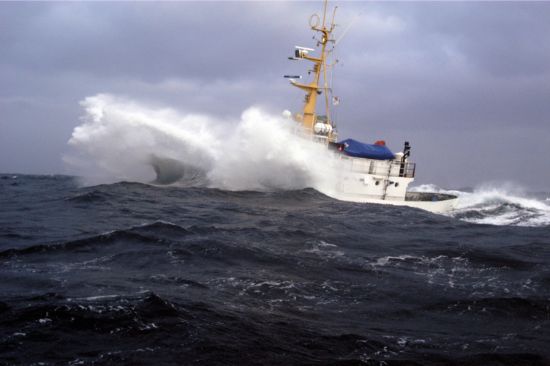
The safe minimum speed to maintain steerageway will vary from boat to boat. It is unlikely to be less than three knots and will be more with craft, which has small rudders. The risk of being knocked off course is greatest with a breaking wave where the water is traveling towards the boat, as this exerts a considerable force on the bow.
If the sea conditions reach the point where the boat has to be forced hard to maintain steerageway in deteriorating conditions, then the time has come to start nursing the boat over the waves. This is when the throttle can be used to good effect. By opening the throttle as the wave approaches, the bow of the boat will lift. A burst of engine power will improve the steering effect at this time. As the bow lifts to the wave, the throttle should be eased off before the bow punches through the crest. Easing the throttle will cause the bow to drop slightly, thus reducing the tendency for it to fall heavily into the trough. As the next wave approaches, it is time to be ready to open the throttles again.

By using this throttling technique, it should be possible to make reasonably comfortable progress to windward. There will be better control of the boat and you will be better prepared if a larger than normal wave comes along. However, this type of operation does require considerable concentration. There is always the risk for that larger-than-normal wave or of being caught out of step by the irregularity of the waves. This need for concentration can be very tiring. You can only retain the right level of concentration for around an hour or so. If you find yourself getting to this stage, perhaps it is time to take a look at your options and find an alternative course.
Planing Boats
When operating a planing boat at displacement speeds, the boat can be more vulnerable than what would be the case with a displacement boat in the same conditions. There are two reasons for this. First, if you are at the point where you have to slow down to displacement speeds in a planing vessel, then conditions are probably becoming quite bad anyway. Second, a planing boat is not running at its optimum at displacement speeds, both in terms of the hull shape and of control.
In terms of hull shape, planing boats tend to have fine bows and full sterns, which is not necessarily a happy combination in rough seas. At the bow, there can be a lack of freeboard when off the plane. This, combined with a fine bow, reduces the buoyancy -- which can mean that the bow buries readily into head seas and it will be your limiting factor.
The boat is also much lighter than a displacement boat and will probably be more affected by wind. So, it may be more difficult to maintain steerageway at low speeds in a planing boat because the bow will want to fly off to one side or the other. This situation will be exaggerated because the rudders are always smaller on fast boats and are therefore less effective at slow speeds. On boats with dynamic steering such as outboards or stern drives where the propeller thrust is used for steering, good steering control can usually be maintained at low speeds.

A delicate hand will be needed on the throttles at displacement speeds because a small movement of the throttle can produce quite a large variation in the speed. However, this can be used to good effect when you need to nurse the boat through the waves where a short burst on the throttle is used to lift the bow and help maintain the heading to approaching waves. The throttle is an instant trim control, lifting the bow when opening and dropping it when closing with only a very little effect on the speed in the short term.
The tactics of operating a planing boat in rough conditions can often mean that rather than reducing speed when operating in a head sea, one should look for an alternative heading for the boat where it can still be operated at higher speeds. For instance, whereas a planing boat may well have to slow right down in a head sea, it can still maintain good speed in beam seas or in following seas particularly. This could be a safer course to take, rather than running the boat at displacement speeds on the original course. Of course, much will depend on the destination you have to reach.
Throttle Control
It would be fair to say that the primary means of control in both semi-displacement and planing hulls is the throttle. By varying the propeller thrust with the throttle, you can raise or lower the bow. But, the throttle has a vital role to play in the speed at which the boat impacts with approaching waves. To a certain extent, this speed of approach determines whether the boat will fly off the top of a wave or not.
Although it can look spectacular when a boat does this, it is not recommended. Every time the boat flies or even partially flies off a wave, it puts enormous stress on the boat, the machinery, and the crew. When we were setting a record around Britain a few years ago in a 50-foot deep-vee, we made it a rule that the hull should never leave the water. In this way, we felt we might be able to cope with standing up in a fast boat for 44 hours.
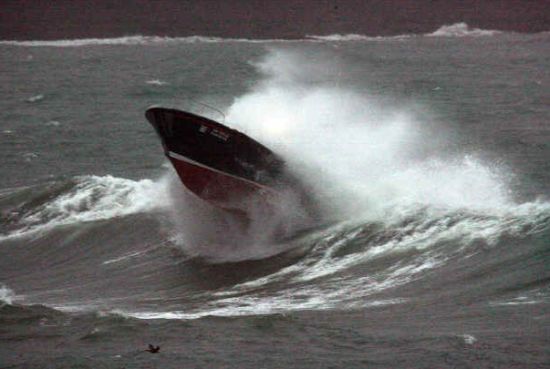
Few cruising boats are likely to attempt such heroics, but the same rule applies. If you do hit bad weather, particularly head seas, then careful throttle control is vital to give the boat as gentle a ride as possible. But, this doesn’t necessarily mean that you have to come down to displacement speeds. In many cases, the bow should be kept up to reduce the chance of water coming over the foredeck. You can also use the change of trim that usually occurs at around 12-15 knots when the hull tries to climb over its bow wave -- to keep the bow up.
Maintaining Trim
Unless the sea gets too rough, it is possible with a deep-vee hull to get it up and running. So, it would stay virtually at a level trim, despite the impact of the waves that try to upset the trim. Much will depend on the wave size and particularly the wavelength. But, if the boat is trimmed properly, it can run virtually across the top of the waves with the control of the boat being exercised solely by the use of the throttle. The biggest problem with this is getting the boat up into this situation. You may have to negotiate several waves rather uncomfortably, as the boat builds up speed and then levels out as it starts to move at high speed.
Getting a boat trimmed in this way is a real joy. It requires careful setting up, using the power trim when available, the flaps and the throttle to keep the balance, as passing waves have varying influences on the hull. With the boat up and running in this way, it is possible to make very rapid progress to windward even though the waves can be quite large. It does require some degree of courage to take the bull by the horns and get the boat up into a situation where one can take advantage of this. It is easy to chicken out before you get into that sweet spot.
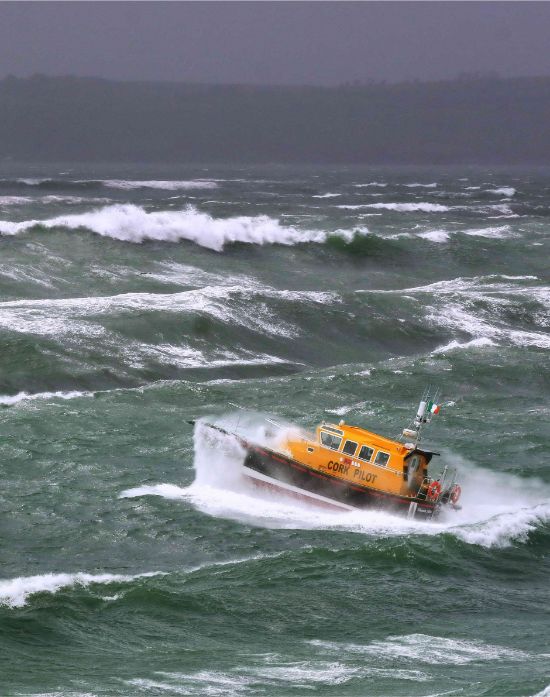
When I was delivering the world’s first large deep-vee hull from Britain to Greece, we managed to get it up and running in this way when the Mistral wind started to kick up a nasty sea in the Mediterranean. The boat was an 85-foot patrol boat for the Greek Navy. The choices were to wallow at displacement speeds for a long night at sea or try the high-speed technique to make harbor in a couple of hours in the rapidly freshening wind. This is probably a technique to use when running for shelter rather than something to do for general cruising. It needs a strong boat and an experienced crew, and it is not likely to be effective on a semi-displacement craft.
When running like this, concentration is needed because there is always the risk that a bigger wave than normal will come along and upset the delicate balance of the boat. A good throttleman will read the waves and concentrate very closely on each one as it approaches, adjusting the throttle almost by instinct as the craft meets the wave -- so that the bow slices through the top without the wave imparting too much lift and allowing the boat to continue on an almost even keel.
With the Greek boat, it took a fair amount of courage to wind the boat up and open the throttles. We suffered a few nasty bangs as we hit the first two or three waves, but soon after the boat really got up on top and, with the flaps down, away we went, traveling at close to 30 knots in conditions where I would never have thought possible for a boat of this size.
Delicate Throttle Use
One of the major ingredients for success, when running a planing boat in rough seas, is to use the throttle very delicately. When a larger wave is seen approaching, the tendency is to pull the throttle back. But, that is the worst thing you can do. Not only will this bring the boat off the plane, but the bow will drop just when you want it up to meet the wave. In most cases, only a slight reduction of the throttle setting will be needed to adjust to the approaching wave, and this will not change the trim too dramatically. You will find that you can make much better progress. This is one of the reasons why I favor throttle controls separate from the gear lever. Then, you have a much wider range of throttle movement, which allows for the more sensitive control that's necessary for this type of driving.
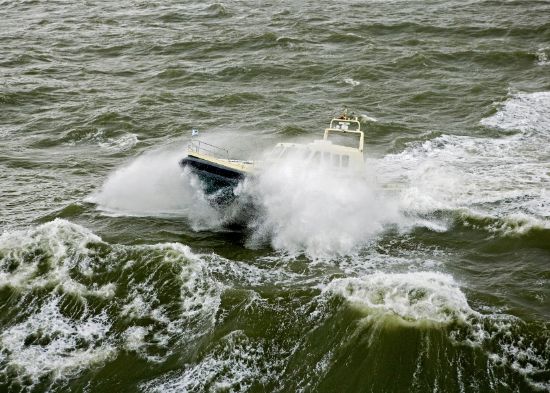
These are short term techniques for use in rough conditions and could help you to get to shelter quickly, so they may have only limited application. You will be less likely to take this sort of chance with a cruising boat, which tends to be less well designed to cope with the heavy impact, which can result if things get out of hand. It is also unlikely on a cruising boat that you will be able to maintain the necessary level of concentration for any length of time. In rough seas, you will be more likely to find a throttle setting at which the boat runs comfortably and let the boat do the work.
In moderate seas, you can often make good progress in this way. Certainly, if you are on a long passage, this takes a lot of the tension out of driving. In moderate conditions, it may be possible to set the autopilot and have a relatively gentle cruise. In a planing boat, it pays to remember the wide variety of shapes and sizes of waves in what may look like a regular sea. If you decide to set the throttle in this way, then the speed at which the boat is running must leave an adequate margin for the boat to ride comfortably over larger than normal waves, without danger or too much discomfort.
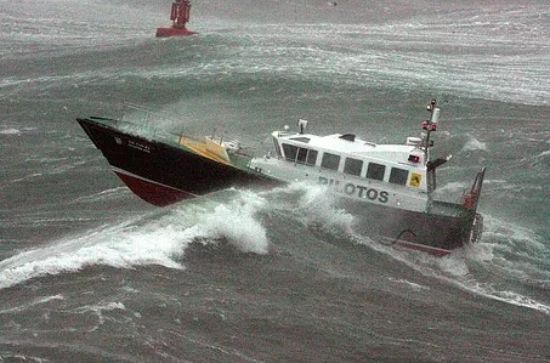
If conditions start to deteriorate, you will find yourself easing back on the throttle because the motion of the boat will soon indicate whether you are pushing things too hard. Fortunately, with most modern fast cruising craft, the weak point in the boat (and the one that generally starts to complain first) is the crew itself, and this is a good safety factor. If the motion starts to get uncomfortable for the crew, you are probably pushing the boat too hard. Easing back the throttle should find a more comfortable speed.
Challenging Conditions
When conditions get to the point where it is difficult to find a comfortable speed and still keep the boat on plane, then you are faced with two options. The first is to ease back and come off the plane and operate the boat in the displacement mode, but this is not always a comfortable option. If you have any doubts about your driving or concentration capabilities, this is probably the wise course of action to adopt. The main secret of fast boat driving into a head sea is to match the speed of the craft to the conditions, and the throttle is the main control to work with. You can benefit from adjusting the flaps to help keep the bow down when on the plane.
The other option open is to alter course. Even a 20-degree alteration can make a significant difference to the way the boat behaves. Altering course off the wind may take you away from the direct course to your destination. But, it will have the effect of extending the wavelength. This reduces the wave gradient, which will give a more comfortable ride. You will need to experiment to find the best amount to alter course. There may be times when you need to turn up into a big wave and reduce speed, or turn away and open the throttles to escape from the section of a wave which is breaking but tacking in this way can be a very effective tactic in rough conditions.
Rough seas are a challenge, and there is no easy solution. So, the weather forecast is your best defense. Do not take any chances. Here we have looked at head sea operations and these are the worst for most leisure boats. We will look at beam and following seas in later articles.